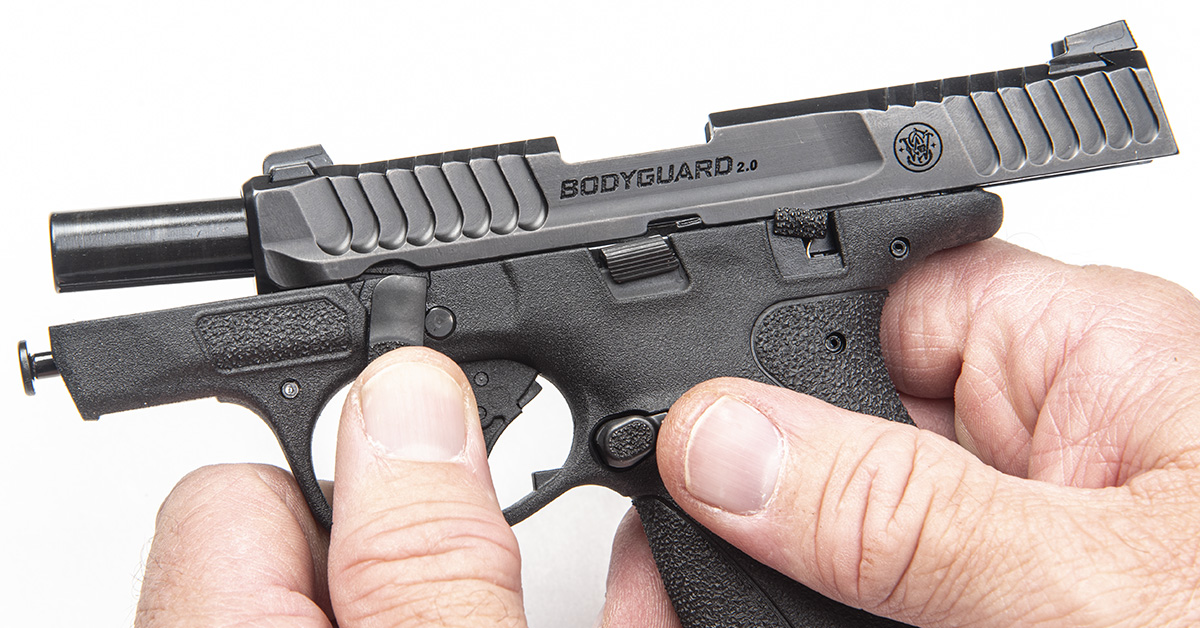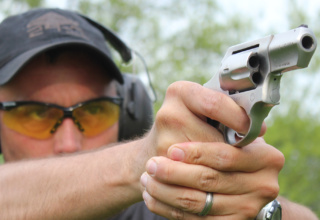As manufacturers continue to expand the micro-pistol category, Smith & Wesson just might have delivered the “One Micro to Rule Them All” with the company’s all-new Bodyguard 2.0
by Rob Reaser
I’ve never been a big fan of micro, or pocket, pistols, and my reasons have always been guided by practicality.
First, in my mind, I could never accept the feasibility of a defensive load that offers anything less than the terminal and ballistic performance of at least a 9mm Luger — never mind the fact that conventional bullet designs have resulted in smaller-caliber projectiles that are wholly viable for close-quarter personal defense use. That is just a bias of mine that I readily admit is open to challenge and negation.
Second, I’ve always found accuracy potential to be quite handicapped in a micro pistol platform when compared to compact and larger-frame handguns. That is not debatable, but it does demand weighing the likely end-use of the firearm. Since personal defense encounters are typically measured in a few feet and not in several yards, it is necessary to consider just how accurate a personal defense weapon must be. The minimum standard, in my mind, is that a gun should deliver reliable point-of-aim, point-of-impact performance within the typical personal defense range. If it does, then I have no standing to object when a gun designed for that close-range purpose struggles to produce 2-inch groups at, say, 25 yards.
Third, I’ve never wrapped my hands around a true micro pistol that felt comfortable and didn’t necessitate compromising my shooting form. From establishing a quick and solid grip to maintaining that grip for follow-up shots, my experience with pocket pistols has always left me walking away from the notion of incorporating one into my personal defense schedule.
Well, after spending two productive days on the range shooting Smith & Wesson’s all-new Bodyguard 2.0 in .380 ACP, I have changed my mind bigly.
Without my hand to provide the perspective, you would be hard-pressed to identify the Bodyguard 2.0 as a genuine micro pistol because its features and relative dimensions are quite similar to that of larger semi-autos. It’s almost as if S&W engineers uncovered a stash of magical shrinking fairy dust and sprinkled it onto a full-size handgun.
Furthermore, the overall profile of the Bodyguard 2.0 is more similar to a larger pistol than is the conventional micro pistol design, which tends to be quite boxy and about as ergonomic looking as a brick, in my humble opinion.
Of course, looks don’t necessarily translate to how a gun feels in the hand. It does, though, with the Bodyguard 2.0.
As you can see, the Bodyguard 2.0 grip boasts a prominent palm swell leading up to a generous beavertail that fully protects the hand from the dreaded micro pistol “slide bite.” Over two days of shooting, never once did the slide scrub the top of my firing hand. I’m not saying that someone with much beefier hands and fingers won’t occasionally be kissed by the slide on recoil, but shooters with average hand sizes will likely never feel the ouch.
Another plus with this more conventional grip design (versus what we typically see in micro pistols) is that the 18-degree grip profile puts the hand higher up on the grip and promotes a straighter wrist angle — both of which enhance control under recoil and shortens the distance between the hand and the barrel bore axis for a more natural aim.
The grip features 360-degree stippling and it is not at all aggressive. The texture is a bit more robust along the backstrap and front strap than along the sides, but overall, the surface is mild compared to many of the small handguns currently on the market. And that is perfectly fine…preferable, in fact, because the small grip circumference means you get a positive, locking grasp on the gun that won’t slip yet the texturing won’t chew your hand during extended range sessions. The milder texturing also reduces fabric snag and wear during deep-concealed carry.
In short, the Bodyguard 2.0 feels just like a miniaturized compact pistol with all the operation controls in all the familiar places. The high cut above the grip combined with a deep undercut of the back of the trigger guard delivered enough acreage for me to get a high and rather full grip on the gun even with the flush 10-round magazine.
The extended 12-round magazine offered full-finger purchase. Again, considering the abbreviated size of the Bodyguard 2.0 — 4 inches high, just less than an inch wide — it’s almost astonishing how this gun feels like something much bigger than it is.
The whole point of a gun this size is, understandably, convenient deep concealment for those times when a larger handgun doesn’t work for the dress or the occasion. Standing, with the Bodyguard 2.0 in my shorts pocket, the gun barely prints, and few would ever notice its presence, let alone recognize it for what it is. Use it with a pocket holster and you’re good to go.
If pocket carry makes you a bit uncomfortable, know that the Bodyguard 2.0 comes with or without a manual thumb safety. I would recommend the thumb safety since it adds an extra layer of operational and carry safety. When the gun is so-equipped, the safety is ambidextrous, so both left- and right-hand shooters can enjoy the benefits.
I have often found that safeties on small pistols like this tend to be difficult to operate in the same fashion as those on larger guns. Not so with the Bodyguard 2.0. Yes, the lever is somewhat stiff and positively snaps into the firing or safe positions, yet I found it easy to manipulate to either position. That is largely due to the aggressive stippling on the tiny lever pad. This no-slip texturing translates to exceptional traction when pushing the lever up or down.
Equally textured with aggressive stippling is the magazine release button. It sits well proud of the frame, making short work of magazine drops. The magazine release is also reversible for left-handed shooters.
Continuing with the operational controls, the Bodyguard 2.0 features lateral serrations on the slide lock lever. This isn’t as sticky as the stippling on the other controls, including the takedown lever, but it does offer enough of a ledge that you’ll have no problem pushing it up to lock the slide back.
When slide manipulation is called for, I found no issues when pulling or pushing the slide rearward thanks to the generous front and rear serrations. I like that the serrations extend to the top edge of the slide, allowing for a good grip regardless of your manipulation style. The force required to manipulate the slide seems modest compared to a lot of micro pistols I’ve tested.
The Bodyguard 2.0 utilizes the single-action-only striker-fired system most of us are familiar with. This is a jump away from the internal hammer, double-action fire control found in the M&P Bodyguard 380.
This move to a striker-fired system allowed S&W engineers the opportunity to develop a fresh trigger. It is a flat-face design with a short-and-crisp sear break that, again, is more akin to a quality trigger system you would typically find on larger pistol platforms. I absolutely like it. I would call the reset relatively short. The trigger pull weight of our test model, based on a 10-pull average, came in at 3 lbs., 2.3 oz.
Sights for the Bodyguard 2.0 are drift adjustable, front and rear. The square post front sight sits low to the receiver flat and includes a tritium insert (for low light visibility) surrounded by an orange focus ring.
In back is a semi-U-notch (or semi-square-notch, depending on how you look at it) rear sight. The front of the sight is flat, allowing for one-handed slide manipulation against a firm surface, should the need arise. The back of the sight hosts blackout serrations to eliminate glare. I like that the rear sight notch is generously proportioned because it gives you plenty of room to align the front sight. I would recommend that S&W, in a future iteration of this model, add a white outline to the rear sight for those of us with increasingly “challenged” vision.
Add a red dot, you say? Unfortunately, no. The slide is not cut for an optic and I know of no optics that have a footprint small enough to accommodate a slide this narrow. But, give it time.
Takedown of the Bodyguard 2.0 is easy. After clearing the gun, lock the slide back and use a suitable tool to push down the ejector. Don’t do this with your finger because if the slide were to come unlocked with your finger in the ejection port, you’re going to have a really bad day.
With the ejector depressed, rotate the takedown lever. Finally, grasp the slide, push down on the lock lever, and move the slide forward and off the frame.
The barrel and recoil spring/guide rod assembly can now be removed from the slide and the gun is ready for cleaning and lubrication.
The diminutive size of the Bodyguard 2.0 gives up nothing in the accuracy department. Yes, bigger guns with longer barrels will hold tighter groups at longer distances, but this pistol is intended for deep concealment and close defensive work. As such, I found its accuracy potential to be outstanding.
Recoil proved mild and thus promoted quick sight realignment.
I did most of the shooting at 10 yards, which is well outside the typical personal defense range of engagement. Employing Fiocchi Range Dynamics FMJ 95-gr., Hornady American Gunner XTP 90-gr., and Federal Premium Hydra-Shok Deep 99-gr. delivered similar results when shooting targets from the bench or silhouettes unsupported. The nod went to the Fiocchi loading with its slightly smaller groups.
In sum, Smith & Wesson absolutely hit the mark with the Bodyguard 2.0. The pistol is super light at 9.8 oz., super small but with the ergonomics of a larger handgun, easy to operate, is uncommonly accurate for its class, and conceals like nobody’s business.
Those who are pondering a micro pistol option for their uber-discreet carry needs should hightail it to their local retailer today.
S&W Bodyguard 2.0 Specifications
- Caliber: .380 Auto
- Action: striker-fired
- Capacity: 10+1, 12+1
- Grip: polymer
- Size: micro
- Barrel Material: stainless steel
- Barrel Finish: Armornite®
- Barrel Length: 2.75 in.
- Twist: 1:10
- Slide Material: stainless steel
- Slide Finish: Armornite®
- Safety: manual thumb (optional)
- Sights: tritium front, U-notch rear
- Trigger: flat-face
- Width: 0.88 in.
- Length: 5.5 in.
- Height: 4 in.
- Weight: 9.8 oz
- MSRP: $449




































